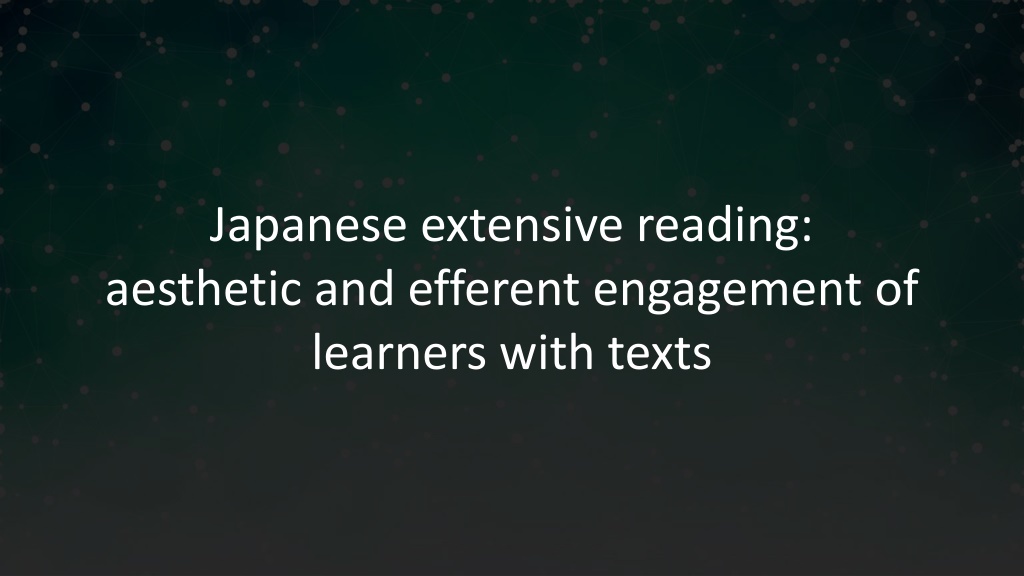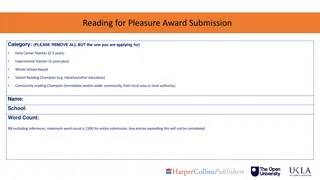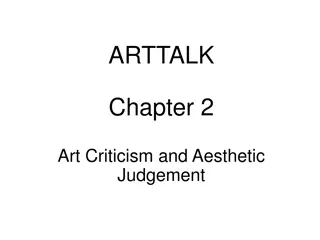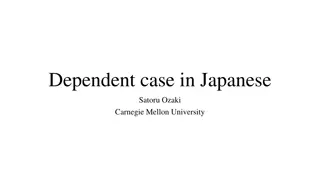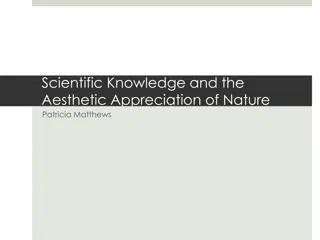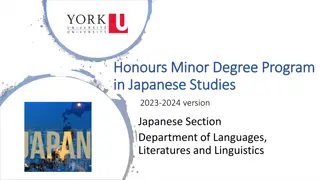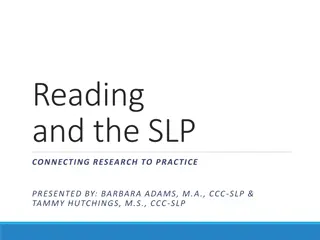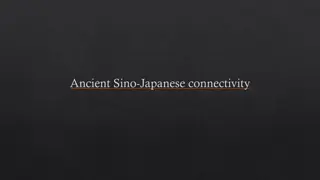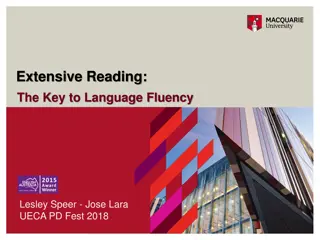Aesthetic and Efferent Engagement in Japanese Extensive Reading
Exploring the engagement of learners with texts in Japanese extensive reading, this study delves into the varied stances of L1 speakers towards reading in Japanese. It discusses the impact of kanji on reading comprehension, the use of furigana for phonetic guidance, and challenges faced by L2 learners. The Japanese writing system, including hiragana, katakana, romaji, and kanji, is analyzed in depth. The report highlights how reading in Japanese is perceived as a language-study activity and its influence on learners.
Download Presentation

Please find below an Image/Link to download the presentation.
The content on the website is provided AS IS for your information and personal use only. It may not be sold, licensed, or shared on other websites without obtaining consent from the author. Download presentation by click this link. If you encounter any issues during the download, it is possible that the publisher has removed the file from their server.
E N D
Presentation Transcript
Japanese extensive reading: aesthetic and efferent engagement of learners with texts
Overview - L1 speakers vary their stances towards texts according to their needs - Reading in Japanese and reading instruction in L2 Japanese classes and how this influences learners to view reading in Japanese as an activity only for language study - Extensive reading and Rosenblatt s continuum of reading engagement - Report on aspects of aesthetic and efferent engagement when reading in Japanese by participants in a small exploratory research project
The Japanese writing system - Two syllabaries ( alphabets where a single letter codes for a syllable), known as hiragana and katakana - The Latin alphabet, known as romaji - Logographs imported from China, known as kanji The issue with kanji - Orthographically opaque (no clear or regular sound-character relationship) - More than 2000 characters need to be memorised to be able to read general Japanese texts (e.g. newspapers, novels) - Each character has 2-4 pronunciations (but many common characters have up to 10), meaning the amount of information to be memorised for each character is very high - Kanji make up 40% of written text, and two-thirds of content words (Matsushita, 2014)
Reading in Japanese as a Japanese learner - Phonetic guides known as furigana or yomigana are usually written on kanji in texts for L1/L2 Japanese learners - Without these guides, only advanced Japanese L2 learners can read Japanese texts, due to the required kanji knowledge needed to assign a phonetic value to each character - L1 Japanese speakers reading of a kanji is consistently mediated by its phonological form before its meaning is retrieved , that is, the grapheme-sound connection is a prerequisite for comprehension (Nara, 2001, p.264) - Indeed, a word [which] cannot be phonologically recode[d] is difficult to integrate as a memory in information processing during a reading act (Ogawa, 1991, p.81, translated by and cited in Tabata-Sandom, 2016, p.26) - Because furigana is absent from most Japanese texts, even many texts produced for the L2 classroom, students tend to experience issues with fluency and quickly recalling [the] meaning and reading of words and kanji while reading ( jbro, 2016, p.ii) - Reading becomes perceived to be a function of how many kanjia learner knows , rather than their ability to integrate information in Japanese across sentences and paragraphs to derive meaning from the text (Austin and Blum, 2009; Everson and Kuriya, 1998; Kondo-Brown, 2006; jbro, 2016)
The approach to reading in the Japanese classroom - Intensive reading of text which is too difficult for students to read on their own; taught as a process of decoding word-by-word, line-by-line (Austin and Blum, 2009; Fukumoto, 2004; Tabata-Sandom, 2015, 2020) - Translation as a primary teaching mode in the foreign language classroom (Tabata-Sandom, 2020, p.48) - Use of translation means learners come to conceive of reading as a demonstration their ability to correctly translate the literal propositional content of the text (Austin and Blum, 2009; Kumagai, 2007; jbro, 2016; Warnick, 2001) - Reading is more than just a process of stringing word beads together (Koda, 2001, p.17) - Texts are treated uncritically as sources of language data (Kumagai, 2007, p.89), and the concept of reading for enjoyment is neglected in the Japanese curriculum (Tabata-Sandom, 2015) - This leads to a tendency of students to believe that reading should be for study and self-improvement only (Abe, 2016, p.88)
The approach to reading in the Japanese classroom - The lack of phonetic guides on kanji on L1 Japanese text leads to a lack of exposure to Japanese texts outside of the L2 Japanese classroom - Consequently the style of instruction in Japanese classrooms and the way texts are read has a significant impact on students development of reading proficiency and their conception of role of written texts in Japanese (Kumagai, 2007; Tabata-Sandom, 2015) - In the end, students are stuck in language study mode - They are unsure about the path to become fluent and independent readers of Japanese who are able to read for a variety of purposes (Tabata-Sandom, 2015) - L1 speakers engage with texts in different ways according to their needs - E.g. learning something, studying, enjoyment, distraction
Rosenblatts transactional theory of reading - Efferent and aesthetic reading stances as two ends of a continuum - Efferent: the reader s attention is centered predominantly on what is to be extracted and retained after the reading event (Rosenblatt, 2018, p.458)* - Aesthetic: the reader pays attention to savors the qualities of the feelings, ideas, situation, scenes, personalities, and emotions that are called forth and participates in the tensions, conflicts, and resolutions of the images, ideas, and scenes as they unfold. (Rosenblatt, 2018, p.458)* - Readers adopt a position on the continuum according to their purpose for reading
Extensive reading and the efferent and aesthetic stances Day and Bamford (2002) s Top Ten Principles Principle 2: A variety of reading material on a wide range of topics must be available - Materials should be as varied as the kinds of purposes for which learners read Principle 3: Learners choose what they want to read - Learners choose what to read to suit their own needs or purpose for reading Principle 5: The purpose of reading is usually related to pleasure, information and general understanding. - Reading activities do not focus on language study: the focus shifts towards the reader's personal experience (Day and Bamford, 2002, p.138) Principle 6: Reading is its own reward - The learners' experience of reading the text is at the center of the extensive reading experience, just as it is in reading in everyday life. (Day and Bamford, 2002, p.138)
The study: a longitudinal exploration of extensive reading in Japanese Participants and institutional context - Twelve students recruited to an exploratory study to investigate the outcomes of extensive reading in Japanese in mid-2017 at a large NZ university - Reading outside of class time, for 10 minutes per day including the weekends - Participants participated in the project for 1-2 semesters (i.e. they read for 13-27 weeks) - Participants had been studying Japanese for either three semesters at university or three or more years at high school and one semester at university before enrolling in the study - Participants had not experienced reading substantial amounts of Japanese texts at their comprehension level before - Prior to beginning the project, they had only read the short reading passages in the Genki textbook used in the course
Data collection procedures - Weekly reading logs - Email as a method to conduct simple interviews - An open-ended questionnaire at the end of the first semester
Materials used - Graded readers for L2 Japanese learners - 143 graded readers across 6 levels from 350 words to 2000 words (NPO Tadoku Supporters, Let s Read Japanese, Sendai International Japanese School) - Graded readers for L1 Japanese children - About 100 books from the Read in 10 Minutes series (10 ) - Children s books - - About 200 semi-graded by NPO Tadoku Supporters About 75 already existing in the library, graded according to Hitosugi and Day (2004) s rubric - Websites - - NHK News Easy Matcha Japanese Tourism Magazine (Easy Japanese version)
Participants David L1=Korean Harriet L1=Chinese Ann L1=English/Chinese Age at start of project 21 Age at start of project 26 Age at start of project 22 No. of years studying Japanese at start of project No. of years studying Japanese at start of project No. of years studying Japanese at start of project 4.5 years 2 years 8 years Participation 13 weeks Participation 12 weeks Participation 27 weeks Cumulative reading time 14 hours (830 mins) Cumulative reading time 26 hours (1580 mins) Cumulative reading time 37 hours (2205 mins) Books read 53 Books read 65 Books read 148 Level of books/articles Levels 0-3 Level of books/articles Levels 0-4 Level of books/articles Levels 0-4 Claire L1=English Gareth L1=Chinese Emily L1=English/Chinese Age at start of project 18 Age at start of project 21 Age at start of project 18 No. of years studying Japanese at start of project No. of years studying Japanese at start of project No. of years studying Japanese at start of project 5 years 2 years 7 years Participation 13 weeks Participation 13 weeks Participation 27 weeks Cumulative reading time 17 hours (1015 mins) Cumulative reading time 21 hours (1240 mins) Cumulative reading time 30 hours (1805 mins) Books read 65 Books read 35 Books read 22 NHK articles read 93 Level of books/articles Levels 3-5, adult Online articles read 31 Level of books/articles Level 2-3 Level of books/articles Levels 2-7
Aesthetic engagement - Emotional reactions to the stories - Harriet: 1/9: The story is so cute. I just can t help smiling when reading it. Harriet: 6/10: It s a touching story. When I read I was moved. I so glad to read such a story. - - Gareth, 5/8: Oh, I mean it s sad, but the ending was beautiful. No one liked Yodaka but it end up as a star on the sky that shines on everyone forever. And also I think the way of the narration is beautiful! - Ann, 12/8: This is probably supposed to be a relatively sad story, and with the illustrations, it made everything much sadder than it could have been! But somehow I was laughing a lot in this story! This was due to the use of words: a serious matter, and (came by) flying! I didn t realise that a TV that isn t working would be that much of a problem!! Really enjoyed this book as it had a lot more other more advanced grammar points that I could understand, it ll be a good way for me to reinforce my Japanese. - Empathising with the characters in the story - Emily, 31/7: Few words that were unfamiliar, but overall understanding was good. The message of the story was clear: Don t say things you don t mean, but I felt like the treatment of the grim reaper was unfair. Harriet, 13/9: Quite touching story. I was moved when I saw wants to start over and be a good man. - - David, 29/8: The grandfather was really kind and he deserves it.
Aesthetic engagement - Being so engaged in the story as to forget about the time - Ann, 14/3: Really enjoying it so far (that s why I went over time without realizing!) - Ann 8/4: Also got carried away reading for a little too long today haha! - Predicting the outcomes of the story - Harriet, 12/9: It s hard to tell the end of the story if I only read half of it. - Ann, 21/3: The last part of the story was very intense! I thought everything was going to be fine with after the 42 days, but it turns out not to be the case! - David, 8/8: I thought the story was going to be a romance at first. It was scary. The guy was lucky to have the girl. - Ann, 11/5: I can feel the tense in this story now! Unsure what will happen next, but I m looking forward to continuing reading on!! - Savouring the story - Harriet, 2/10: Akutagawa s story is always attractive to me. I so love this one and took more time to feel the things hidden behind words
Aesthetic engagement - Relating to childhood experiences - Claire, 15/8: I m pretty sure I read Titch when I was a kid, kinda exciting - David, 20/10: I felt like I went back to a kid. I used to like reading books when I was young and it gave me the feeling back that I forgot ages ago - Ann, 17/5: I think because I grew up watching this over and over again, it was and still is one of my favourite movies (despite the sad parts that do happen!); I am enjoying this read even though I don t understand all the small details of what s happening!!
Efferent engagement - Connecting NHK Easy articles to their regular newspaper reading habit - Claire, 18/10: NHK was the website I used most, I think I want to make it a habit now until I can read the actual news! This was probably my favourite reading material as (perhaps due to the association of news with adults and sophisticated language) I felt rather accomplished after finishing a news article. I also liked being able to go to my regular news site, the Guardian, afterwards and feel nifty about already knowing what was happening in the world, then being able to expand on it with a more sophisticated English text. The context and real life knowledge I already have on the news also helped make it easier to guess some of the words I didn t fully understand the meaning of. Also I keep hitting the paywall on Japantimes.com, so this is a nice way to keep up with stuff in Japan. - Gaining new knowledge through Japanese - Claire, 2/9: Woah, this book is interesting. It s so satisfying learning about things for the first time in Japanese. New fav - David, 28/8: I now know how to make tofu and soy sauce - David, 19/8: I didn t know monkeys could eat fish. I always thought they just eat fruits like banana. - Ann, 2/8: I learnt a lot from this one, particularly the instructions on how to make sushi. I ve never come across a recipe in Japanese before, so it s nice to see that recipes in a different language isn t so scary after all! I learnt how the sentences for the instructions actually have a lot of commas! - Harriet, 4/1: I learned many ways to describe how strong the earthquake is, and how to improve survival chance.
Efferent engagement - Learning about Japanese culture/history/myths - Harriet 7/10: Illustrations are superb. Japan old gods are interesting people. - Ann, 1/8: Nice to have a quick dose of Japanese culture! A short story based on a true story from the past! It s fascinating how a dog can have survived on its own for so long and its dedication to its owner. Would love to encounter more short stories like this that are easy to read and understand, to get my dose of Japanese culture! - David, 21/8: It was good to know some festivals and traditions of Japan. - David, 29/9: I didn t know that they also celebrate tanabata a month later in Sendai. Also, I want to spend my holiday in Japan hanging out with host family. - Ann, 10/4: Came across this book in the library and reading the title, it seemed to be interesting. It is a level 4 book, but since it was on Japanese dining, I thought I d give it a try. - David, 26/9: I have never caught the train at 7:30 am. I would like to see how busy it is when I visit Japan. - Harriet, 8/9: It s interesting to know how to take bath in Japan - David, 18/9: It was interesting to see some of the statistics about Japan. - Emily, 7/8: Interesting reading about all the desserts with Sakura in them - David, 7/10: I was wondering what s the meaning behind the neko when I was in Japan but forgot to search it. Now I know.
Efferent engagement - Seeking knowledge for future travel to Japan - Ann, 27/5: Didn t know what this book was going to be about, but thought it would help me understand Tokyo a bit since I ll be going there for the first time soon! - Life advice - David, 24/9: Reminded me how bad it is to be lazy - David, 9/8: It was really meaning full. It reminded me preparing earlier is better - Relating storyline to previous knowledge about the genre - Ann, 12/5: Finished this story. Thought it would end well with possibly and marrying, but they both die :/ Before that though, finds out is actually a female, seems like he didn t mind... this is quite a typical storyline in many Chinese dramas based on Ancient storylines! ... but not them dying though, usually they get married and live happily ever after. Didn t happen here though :( being forced to marry another richer man is also quite a typical thing that happens in these Chinese dramas haha!
Efferent engagement - Understanding mother s cultural beliefs Ann, 29/9: = Buddhist Deity of Compassion/Mercy. Knew this, as I ve come across it before from my mum... I think I would have just referred to it as some Buddhist figure, but I also remember coming across Buddha as in a previous book I read recently, so I thought I d dig into it a little more, and found that it s really Buddhist Deity of Compassion/Mercy . Both isn t too new to me I guess, since I ve heard of these from my mum (although I never really understood what they meant or were haha!) and a friend, but what really got me into searching deeper what was when I first Google searched it, and it came up with Mr. Kan on or Avalokite vara , which got me really curious, as I was pretty confident with what I know this is of, and the Google images (as well as the illustration from the book) returned back what I knew it is... but searching up the meaning didn t! ~ it s really interesting haha! But I finally found out it was Buddhist Deity of Compassion/Mercy though! :) Hopefully now I ll also understand a bit more about Japanese culture/beliefs, as well as my mum! :P -
The aesthetic and efferent engagement of L2 Japanese readers with Japanese texts - Through engaging in out-of-class extensive reading, it can be seen that learners are able adopt a variety of stances along the efferent-aesthetic continuum, not just language study-related purposes - An important complement to traditional reading approaches for this reason
Reference List Abe, K. (2016). Roles of technology and of reading among five self-directed adult learners of Japanese as a foreign language. (Unpublished PhD thesis). The University of Texas at Austin, Texas, United States of America. Austin, T., & Blum, M. (2009). Collaborative action research: Building authentic literate practices into a foreign language program. Colombian Journal of Applied Linguistics, 11, 29-47. Day, R., & Bamford, J. (2002). Top ten principles for teaching extensive reading. Reading in a Foreign Language 14(2), 136-141. Everson, M. E., & Kuriya, Y. (1998). An exploratory study into the reading strategies of learners of Japanese as a foreign language. The Journal of the Association of Teachers of Japanese, 26(1), 1-21. Fukumoto, A. (2004). [An experiment in extensive reading in Japanese education]. Japanese Language and Culture, 30, 41 59. Kumagai, Y. (2007). Tension in a Japanese language classroom: An opportunity for critical literacy?. Critical Inquiry in Language Studies, 4(2-3), 85-116. Kondo-Brown, K. (2006). Affective variables and Japanese L2 reading ability. Reading in a Foreign Language, 18(1), 55-71. Matsushita, T. (2014, August 15). How is the relationship between vocabulary knowledge and comprehension? A case of Japanese [Paper presentation]. AILA World Congress 2014, Brisbane. Nara, H. (2001). Automaticity and its implications for JFL pedagogy. In Nara, H. (Ed.), Advances in Japanese language pedagogy (pp. 243-280). Columbus, Ohio: National East Asian Language Resource Center, Ohio State University. jbro, J. (2016). I need to prove comprehension : Experiences of literacy development of Swedish university students of Japanese. (Unpublished master s thesis). University of Stockholm, Stockholm, Sweden. Rosenblatt, L.M. (2018). The transactional theory of reading and writing. In Alvermann, D.E., Unrau, N.J., Sailors, M., & Ruddell, R.B. (Eds.), Theoretical Models and Processes of Literacy (7th ed.) (pp.451-479). Routledge. Tabata-Sandom, M. (2016). What types of texts and reading aids are good for Japanese graded readers?. Journal of Extensive Reading 4(2), 21-46. Tabata-Sandom, M. (2015). L2 reading perceptions of learners of Japanese: The influence of the reading instruction. Reading Matrix, 15(1), 274 289. Tabata-Sandom, M. (2020). Teachers cognition regarding reading instruction in L2 Japanese. Reading Matrix, 20(2), 41-60. Warnick, J. P. (2001). Reading as socio-cultural performance. In Nara, H. (Ed.), Advances in Japanese language pedagogy (pp.137-180). Columbus, Ohio: National East Asian Language Resource Center, Ohio State University.
